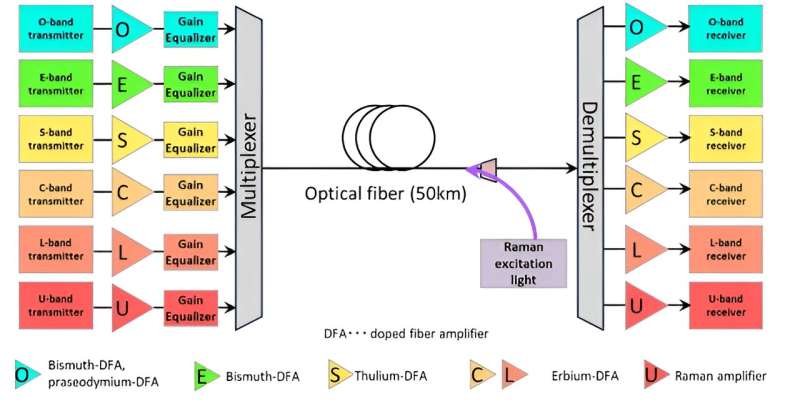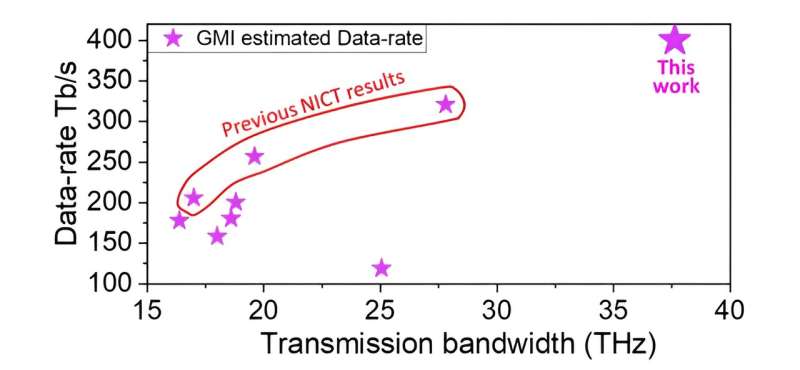This article has been reviewed according to Science X's editorial process and policies. Editors have highlighted the following attributes while ensuring the content's credibility:
fact-checked
proofread
World record 402 Tb/s transmission in a standard commercially available optical fiber

An international joint research team led by the Photonic Network Laboratory of Japan's National Institute of Information and Communications Technology (NICT) has demonstrated a record-breaking aggregate optical transmission bandwidth of 37.6 THz to enable a new data-rate record of 402 terabits per second in a standard commercially available optical fiber.
This record was achieved by constructing the first optical transmission system covering all the transmission bands (OESCLU) of the low-loss window of standard optical fibers. The system combined various amplification technologies, some developed for this demonstration, including six kinds of doped fiber optical amplifiers and both discrete and distributed Raman amplification.
Novel optical gain equalizers also allowed access to new wavelength bands that are not yet utilized in deployed systems. The newly developed technology is expected to make a significant contribution to expanding the communication capacity of the optical communication infrastructure as future data services rapidly increase demand.
The results of this experiment were accepted as a post-deadline paper at the 47th International Conference on Optical Fiber Communications (OFC 2024) and presented by Ben Puttnam on Thursday March 28, 2024 at the San Diego Convention Center, California, U.S.
The growth of the internet and data-services has driven demand for optical transmission bandwidth. To meet this demand, multi-band wavelength division multiplexing (WDM) technology, where new spectral windows are used to increase optical fiber transmission bandwidth, has become a popular research topic.

Utilizing new transmission windows in deployed fibers also offers a potentially significant benefit in the near-term as a method of extending the life of existing fiber systems to provide additional transmission capacity without the large capital expenditure associated with new fiber deployment. However, moving away from the lowest loss regions of standard silica fibers requires new amplification schemes beyond the standard erbium (E-) doped fiber amplifier (DFA) that is a staple of C-band or C+L-band systems.
Previously, S/C/L-band transmission has been explored with various amplifier solutions. In addition to thulium (T-) DFAs, semiconductor optical amplifiers (SOAs) and distributed and discrete Raman amplification have been used, with maximum estimated data-rates of 256 Tb/s utilizing almost 20 THz bandwidth.
Even wider transmission demonstrations have used bismuth (B-DFAs) for O-band and lumped Raman amplifiers for U-band channels for 119 Tb/s with a cumulative bandwidth of 25 THz. E-band BDFAs were also used with distributed Raman amplification for E/S/C/L-band transmission over 27.8 THz with
In this demonstration, researchers expanded dense wavelength division multiplexed (DWDM) transmission to cover all the major transmission bands in the low-loss window of standard optical fibers to enable more than 1,500 parallel transmission channels within an aggregate 37.6 THz (275 nm) optical bandwidth.
Along with collaborating partners, NICT constructed the world's first O to U-band transmission system capable of DWDM transmission in a commercially available standard optical fiber achieved with custom designed amplifier technology. The transmission demonstration utilizes 6 DFA variants for gain in O/E/S/C/L-bands with discrete (U-band) and distributed Raman amplification along with novel optical gain equalizers for profile shaping in O/E bands.

A wideband DWDM signal including up to 1,505 channels covering 275 nm (37.6 THz), from 1,281.2 nm to 1,649.9 nm across the O, E, S, C, L and U-bands, was transmitted over 50 km of water absorption peak suppressed optical fiber. High data rates were achieved by using dual polarization (DP-) quadrature-amplitude modulation (QAM) with up to 256 symbols per constellation.
As highlighted, the generalized mutual information (GMI) estimated data-rate after 50 km transmission was 402 Tb/s, which exceeds the previous highest single-mode fiber (SMF) data-rate by over 25%, and the aggregate transmission bandwidth of 37.6 THz is also a 35% increase. The achieved data-rate is compared with past achievements in wideband transmission experiments. These results show the potential of ultra-wideband transmission, enabled by a new amplifier and wideband spectrum-shaping technology to increase the information carrying capability of new and deployed optical fibers.
It is expected that the data-rate of optical transmission systems required to enable "beyond 5G" information services will increase enormously. New wavelength regions enable deployed optical fiber networks to perform higher data-rate transmission and extend the useful life of existing network systems. It is also anticipated that new bands can address the increasing demand of next generation communications services by combining with new types of optical fibers.
The paper containing these results was presented at the Optical Fiber Communication (OFC) Conference 2024, the largest international optical communications conference, having been selected as a post-deadline paper.
NICT will continue to promote research and development into new amplifier technologies, components, and fibers to support new transmission windows for both near and long-term applications. NICT will also aim to extend the transmission range of such wideband, ultra-high-capacity systems and add their compatibility for field-deployed fibers.
Provided by National Institute of Information and Communications Technology (NICT)



















